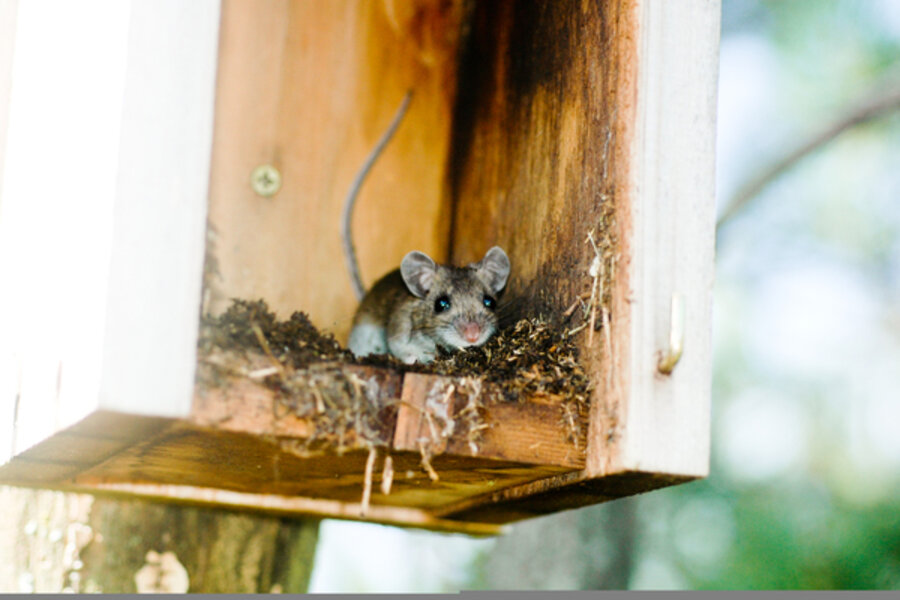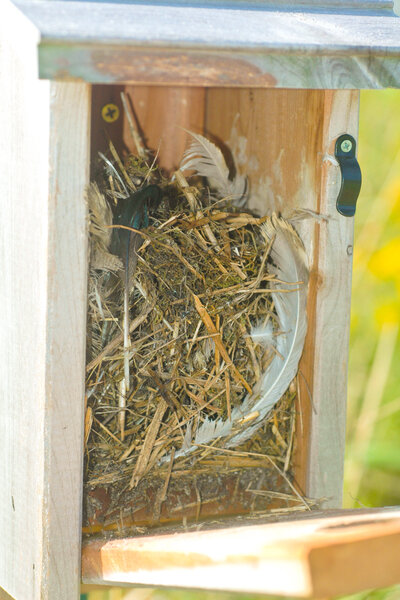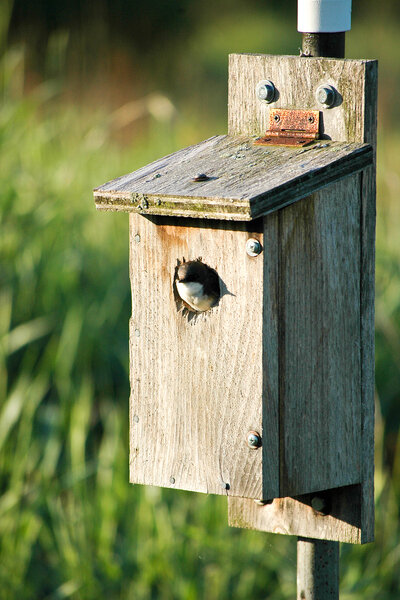Fall house cleaning -- birdhouses, that is
Loading...
Cavity-nesting birds use birdhouses as nurseries, not homes, so, come fall, it’s time to clean out the nursery. It’s a job I always rope my husband into; tongue-in-cheek, he calls it “our quality time.”
Cleaning out birdhouses isn’t without surprises. When we spent a year in Durham, N.C., our next-door neighbor pulled a four-foot black rat snake out of his purple martin house.
We discovered nothing so startling last week, although we did find paper wasps in one house and deer mice in three others [see photo at top]. The remaining four houses were filled with an assortment of grasses, twigs, leaves, feathers, and mosses — and wildlife too small to see. [See first photo at left.]
All these houses were designed for Sialia sialis, the Eastern bluebird. Males and females arrive in spring, investigate two or three houses, and then the male steps back and allows the female to build the nest.
That’s the best-case scenario. More commonly, the bluebirds are usurped by tree swallows [see second photo at left; click on arrow at right base of first photo] or, worse yet, house sparrows.
Birds have preferences about houses, and a fine reference book is Carrol Henderson’s "Woodworking for Wildlife," but there also are good sites on the Web that provide details about which bird likes what.
Whomever the occupant, birdhouses need to be cleaned out once the babies fledge. Old nests harbor parasites and diseases, and few birds clean out the rubbish left by previous residents. Be sure to wear gloves when you undertake this task — a case of bird mites isn't fun — and avoid breathing dust from the nest.
After cleaning out the house, disinfect it with a 10 percent bleach spray (1 part bleach to 9 parts water), then leave the house open a day or two to dry out. Chlorine oxidizes quickly, usually in 24 hours, so you don’t need to rinse the house. But you do need to wash and rinse your hands when you’re done.
Best types of birdhouses
All this is made much easier if the birdhouse has a hinged front panel rather that a hinged roof. If you’re buying or building a birdhouse, it also needs drainage holes in the floor, ventilation holes near the roof, and should be made of untreated wood.
And a birdhouse should not have a perch, which is unnecessary for the bird but attractive to predators.
Unenlightened merchants are prepared to sell you birdhouses that resemble Japanese pagodas, gothic cathedrals, Maine lighthouses, and Elvis’s mansion in Memphis.
For the record, most birds -- with the exception of wrens -- are not attracted to architectural replicas. Wrens seem willing to nest in almost anything left outdoors, including clothespin bags, flowerpots, hats, shoes, mailboxes, and probably miniature Gracelands.
Birds and the gardener
And what does this have to do with gardening?
In addition to being fun to watch, birds eat scores of weed seeds and insects that plague garden plants. Three-quarters of the Eastern bluebird’s diet is insects, and wrens gobble up ants, beetles, cutworms, grasshoppers, leafhoppers, and wasps, and that’s an incomplete menu.
As wildlife biologist John Sterling writes, “Birds are technologically advanced, highly motivated, extremely efficient, cost-effective insect pest controllers.”
And a final piece of advice: It’s always good to recheck birdhouses in very early spring, especially if, like me, you find mice in residence. Persistent little buggers, mice are likely to resettle in a birdhouse hours after you clean it out.
-----
Karan Davis Cutler blogs regularly at Diggin’ It. To read more, click here. She's a former magazine editor and newspaper columnist and the author of scores of garden articles and more than a dozen books, including “Burpee -- The Complete Flower Gardener” and “Herb Gardening for Dummies.” Karan now struggles to garden in the unyieldingly dense clay of Addison County, Vt., on the shore of Lake Champlain, where she is working on a book about gardening to attract birds and other wildlife







